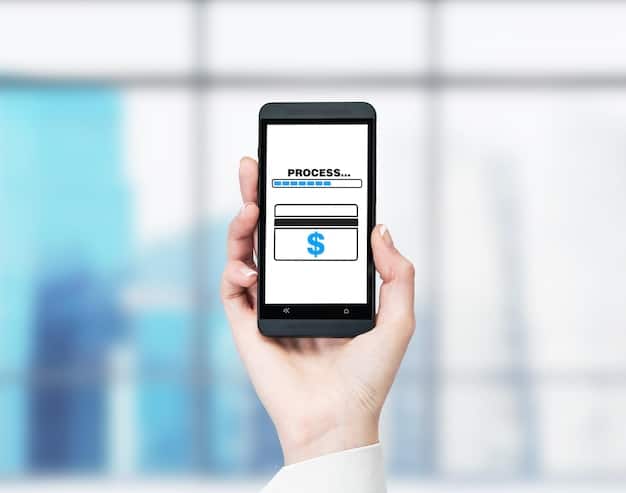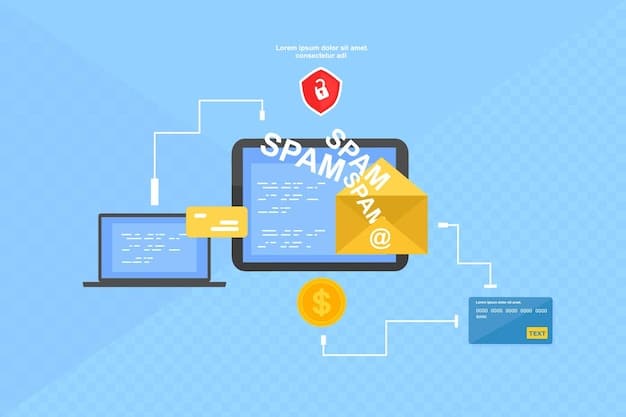Payment Gateway Integration: A Guide for US E-commerce

Payment gateway integration involves seamlessly connecting your e-commerce platform with a payment processor to securely handle online transactions, crucial for US businesses to ensure customer trust and efficient operations, providing a smooth checkout experience.
Navigating the world of e-commerce in the US requires a strong focus on secure and reliable payment processing. Implementing a robust payment gateway integration: a step-by-step guide for US e-commerce businesses to ensure secure transactions is essential for building trust with your customers and ensuring smooth business operations.
Understanding Payment Gateways: A Key Component for US E-commerce
In the American e-commerce landscape, a payment gateway serves as a critical bridge between your online store and the financial network. It ensures that customer transactions are processed securely and efficiently. Understanding its function and choosing the right one is paramount for success.
What is a Payment Gateway?
A payment gateway is a service that authorizes credit card or direct payments processing for e-businesses, online retailers, or traditional brick and mortar stores. It acts as an intermediary between the customer, the merchant, and the bank, ensuring secure communication of sensitive financial information.
Why is it Important for US E-commerce?
For US e-commerce businesses, a reliable payment gateway is essential for several reasons. It provides secure transaction processing, enhances customer trust, facilitates PCI compliance, and enables access to a wider customer base. Without a secure and efficient payment gateway, businesses risk losing sales and damaging their reputation.
- Security: Protects sensitive customer data during transactions.
- Trust: Builds confidence among customers in the US market.
- Compliance: Helps meet regulatory requirements like PCI DSS.
- Reach: Allows acceptance of various payment methods, broadening customer reach.
In essence, payment gateways are the gatekeepers of your revenue stream, ensuring that every transaction is handled with utmost security and efficiency. This foundational element sets the stage for a successful and trustworthy e-commerce presence in the US market.
Step-by-Step Guide: Integrating a Payment Gateway
Integrating a payment gateway into your US e-commerce platform doesn’t have to be a daunting task. By following a structured step-by-step approach, you can ensure a smooth and secure implementation. This guide is designed to walk you through the process.
Step 1: Choosing the Right Payment Gateway
Selecting the right payment gateway is a critical first step. Consider factors like transaction fees, supported payment methods, security features, integration capabilities, and customer support quality. Research different providers like Stripe, PayPal, Authorize.net, and Braintree, comparing their offerings to your specific business needs.
Step 2: Setting Up a Merchant Account
A merchant account is a bank account that allows you to accept credit and debit card payments. Some payment gateways, like Stripe and PayPal, offer integrated merchant accounts, while others require you to set up a separate account. Compare the fees and terms associated with different merchant account options.

Step 3: Coding the Integration
This involves connecting your e-commerce platform to the payment gateway using its API (Application Programming Interface). You’ll need to write code to send transaction data to the gateway and receive responses. Most gateways provide detailed documentation and code examples to assist with this process.
- API Keys: Obtain the necessary API keys from your payment gateway provider.
- Libraries: Use pre-built libraries or SDKs (Software Development Kits) to simplify the integration.
- Documentation: Refer to the gateway’s API documentation for coding guidelines.
Step 4: Testing the Integration
Before going live, thoroughly test the integration to ensure everything works correctly. Use test credit card numbers and mock transactions to simulate different scenarios, such as successful payments, declined payments, and error conditions.
By meticulously following these steps, you can successfully integrate a payment gateway into your US e-commerce platform, ensuring secure and efficient transaction processing.
Ensuring Secure Transactions: Best Practices
Security is a paramount concern for both e-commerce businesses and their customers. Implementing best practices for secure transactions is essential for building trust and protecting sensitive data.
PCI DSS Compliance
The Payment Card Industry Data Security Standard (PCI DSS) is a set of security standards designed to protect cardholder data. Ensure your payment gateway and e-commerce platform are PCI DSS compliant. This involves implementing security controls like encryption, firewalls, and access controls.
Tokenization
Tokenization replaces sensitive cardholder data with a non-sensitive “token.” This token can be used for future transactions without storing the actual credit card number. Many payment gateways offer tokenization services to enhance security.
Encryption
Encryption scrambles data so it’s unreadable to unauthorized parties. Use HTTPS (Hypertext Transfer Protocol Secure) to encrypt all communication between your website and the payment gateway. Additionally, ensure your payment gateway uses strong encryption algorithms.
- HTTPS: Use HTTPS for all pages on your website, especially the checkout page.
- SSL Certificates: Obtain and maintain a valid SSL (Secure Sockets Layer) certificate.
- End-to-End Encryption: Look for payment gateways that offer end-to-end encryption of transaction data.
Fraud Prevention
Implement fraud prevention measures to detect and prevent fraudulent transactions. This can include address verification, CVV verification, and fraud scoring systems. Monitor transactions for suspicious activity and implement manual review processes for high-risk orders.
By implementing these best practices, you can significantly enhance the security of your online transactions, protecting your business and your customers from fraud and data breaches. This is crucial for maintaining a positive reputation and fostering customer loyalty in the competitive US e-commerce market.
Factors to Consider When Choosing a Payment Gateway
Selecting the right payment gateway involves carefully evaluating several factors to ensure it aligns with your business needs and goals. These factors include transaction fees, supported payment methods, security features, and integration capabilities.
Transaction Fees
Transaction fees are a significant cost associated with payment gateway usage. Compare the fees charged by different providers, including per-transaction fees, monthly fees, and setup fees. Understand the pricing structure and choose a gateway that offers competitive rates and transparent billing.
Supported Payment Methods
Ensure the payment gateway supports the payment methods your customers prefer. In the US market, this typically includes major credit cards (Visa, Mastercard, American Express, Discover), debit cards, and alternative payment methods like PayPal, Apple Pay, and Google Pay.

Security Features
Security should be a top priority when choosing a payment gateway. Look for gateways that offer robust security features like PCI DSS compliance, tokenization, encryption, and fraud prevention tools. Ensure the gateway has a strong track record of protecting sensitive data.
Integration Capabilities
The payment gateway should seamlessly integrate with your e-commerce platform and other business systems. Check if the gateway offers pre-built integrations or APIs that allow you to easily connect it to your website, shopping cart, and accounting software.
By carefully considering these factors, you can select a payment gateway that meets your specific needs, providing secure, efficient, and cost-effective transaction processing for your US e-commerce business.
Optimizing the Checkout Experience
A smooth and user-friendly checkout experience is crucial for maximizing sales and reducing cart abandonment. Optimizing the checkout process involves minimizing friction and providing a seamless payment experience for your customers.
Simplified Checkout Forms
Keep your checkout forms as simple and concise as possible. Only ask for essential information and avoid unnecessary fields. Use address auto-completion and other features to streamline the form-filling process.
Mobile Optimization
Ensure your checkout process is optimized for mobile devices. With an increasing number of customers shopping on mobile, a mobile-friendly checkout is essential for capturing sales.
Multiple Payment Options
Offer a variety of payment options to cater to different customer preferences. This can include credit cards, debit cards, PayPal, Apple Pay, Google Pay, and other alternative payment methods. Giving customers choices can increase conversion rates.
- Guest Checkout: Allow customers to checkout without creating an account.
- Clear Error Messages: Provide clear and helpful error messages to guide customers through the checkout process.
- Progress Indicator: Use a progress indicator to show customers where they are in the checkout process.
Trust Signals
Display trust signals throughout the checkout process to reassure customers about the security of their transactions. This can include displaying security badges, SSL certificates, and customer testimonials.
By optimizing the checkout experience, you can create a seamless and trustworthy payment process that encourages customers to complete their purchases. This is a key factor in driving sales and fostering customer loyalty for your US e-commerce business.
Troubleshooting Common Payment Gateway Issues
Even with the best planning and implementation, issues can arise with your payment gateway integration. Knowing how to troubleshoot common problems can help you quickly resolve them and minimize disruptions to your business.
Transaction Errors
Transaction errors can occur for various reasons, such as incorrect card details, insufficient funds, or technical issues. Provide clear error messages to customers and offer helpful solutions, such as verifying their card details or contacting their bank.
Connectivity Problems
Connectivity problems between your e-commerce platform and the payment gateway can prevent transactions from being processed. Check your internet connection and ensure the payment gateway’s API is functioning correctly. Contact the gateway provider’s support team for assistance if needed.
Security Alerts
Security alerts can indicate potential fraud or security breaches. Investigate any security alerts promptly and take necessary steps to mitigate the risk. This may involve contacting the payment gateway provider, reviewing your security settings, or contacting law enforcement.
- Check Logs: Review transaction logs for detailed information about errors.
- Contact Support: Don’t hesitate to contact the payment gateway’s support team for assistance.
- Monitor Regularly: Regularly monitor your payment gateway integration for any issues.
By proactively addressing and troubleshooting common payment gateway issues, you can ensure a smooth and secure payment processing experience for your customers. This helps maintain customer trust and minimizes the impact of technical problems on your business operations.
| Key Aspect | Brief Description |
|---|---|
| ✔️ Choosing a Gateway | Select a gateway that fits your business needs, considering fees and security. |
| 🔒 Security Measures | Implement PCI DSS compliance and tokenization for secure transactions. |
| 📱 Mobile Optimization | Ensure compatibility on devices to enhance the checkout experience. |
| 💰 Fee Structure | Consider transaction, monthly, and setup fees to make the right decision. |
Frequently Asked Questions (FAQ)
▼
A payment gateway is a technology that merchants use to accept debit or credit card purchases from customers. It’s crucial for e-commerce as it secures and transmits transaction data between the customer, merchant, and payment processor, facilitating smooth online sales.
▼
Consider transaction fees, supported payment methods, security features like PCI compliance, and integration capabilities with your e-commerce platform. Read customer reviews and compare different gateways to find the best fit.
▼
Prioritize PCI DSS compliance, tokenization, and encryption. These features ensure that sensitive cardholder data is protected during transactions, reducing the risk of fraud and data breaches for both you and your customers.
▼
Yes, integrating multiple payment gateways can provide flexibility for your customers. Offering a variety of payment options, such as credit cards, PayPal, and other digital wallets, can enhance the customer experience and increase conversion rates.
▼
Review the transaction logs for detailed error information, contact the payment gateway’s support team for assistance, and ensure your system is properly configured. Proactive monitoring and quick response can minimize disruptions.
Conclusion
Successfully integrating a payment gateway is a cornerstone of any thriving US e-commerce business, ensuring secure, efficient, and reliable transactions. By carefully selecting the right gateway, implementing robust security measures, and continuously optimizing the checkout experience, you can build customer trust, drive sales, and position your business for long-term success in the competitive online marketplace.





